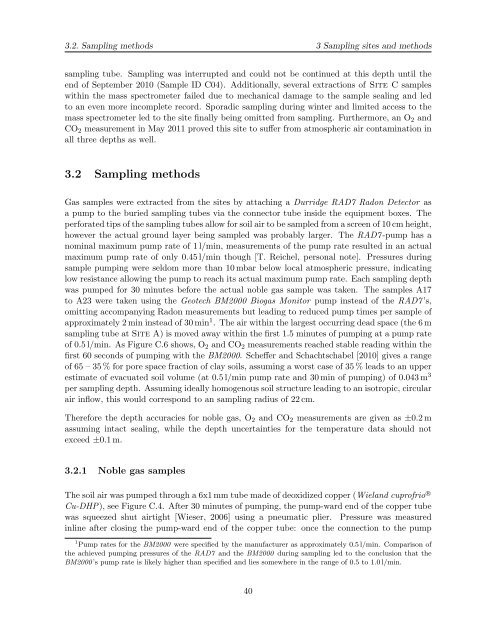Diploma thesis in Physics submitted by Florian Freundt born in ...
Diploma thesis in Physics submitted by Florian Freundt born in ...
Diploma thesis in Physics submitted by Florian Freundt born in ...
Create successful ePaper yourself
Turn your PDF publications into a flip-book with our unique Google optimized e-Paper software.
3.2. Sampl<strong>in</strong>g methods 3 Sampl<strong>in</strong>g sites and methods<br />
sampl<strong>in</strong>g tube. Sampl<strong>in</strong>g was <strong>in</strong>terrupted and could not be cont<strong>in</strong>ued at this depth until the<br />
end of September 2010 (Sample ID C04). Additionally, several extractions of Site C samples<br />
with<strong>in</strong> the mass spectrometer failed due to mechanical damage to the sample seal<strong>in</strong>g and led<br />
to an even more <strong>in</strong>complete record. Sporadic sampl<strong>in</strong>g dur<strong>in</strong>g w<strong>in</strong>ter and limited access to the<br />
mass spectrometer led to the site f<strong>in</strong>ally be<strong>in</strong>g omitted from sampl<strong>in</strong>g. Furthermore, an O2 and<br />
CO2 measurement <strong>in</strong> May 2011 proved this site to suffer from atmospheric air contam<strong>in</strong>ation <strong>in</strong><br />
all three depths as well.<br />
3.2 Sampl<strong>in</strong>g methods<br />
Gas samples were extracted from the sites <strong>by</strong> attach<strong>in</strong>g a Durridge RAD7 Radon Detector as<br />
a pump to the buried sampl<strong>in</strong>g tubes via the connector tube <strong>in</strong>side the equipment boxes. The<br />
perforated tips of the sampl<strong>in</strong>g tubes allow for soil air to be sampled from a screen of 10 cm height,<br />
however the actual ground layer be<strong>in</strong>g sampled was probably larger. The RAD7 -pump has a<br />
nom<strong>in</strong>al maximum pump rate of 1 l/m<strong>in</strong>, measurements of the pump rate resulted <strong>in</strong> an actual<br />
maximum pump rate of only 0.45 l/m<strong>in</strong> though [T. Reichel, personal note]. Pressures dur<strong>in</strong>g<br />
sample pump<strong>in</strong>g were seldom more than 10 mbar below local atmospheric pressure, <strong>in</strong>dicat<strong>in</strong>g<br />
low resistance allow<strong>in</strong>g the pump to reach its actual maximum pump rate. Each sampl<strong>in</strong>g depth<br />
was pumped for 30 m<strong>in</strong>utes before the actual noble gas sample was taken. The samples A17<br />
to A23 were taken us<strong>in</strong>g the Geotech BM2000 Biogas Monitor pump <strong>in</strong>stead of the RAD7 ’s,<br />
omitt<strong>in</strong>g accompany<strong>in</strong>g Radon measurements but lead<strong>in</strong>g to reduced pump times per sample of<br />
approximately 2 m<strong>in</strong> <strong>in</strong>stead of 30 m<strong>in</strong> 1 . The air with<strong>in</strong> the largest occurr<strong>in</strong>g dead space (the 6 m<br />
sampl<strong>in</strong>g tube at Site A) is moved away with<strong>in</strong> the first 1.5 m<strong>in</strong>utes of pump<strong>in</strong>g at a pump rate<br />
of 0.5 l/m<strong>in</strong>. As Figure C.6 shows, O2 and CO2 measurements reached stable read<strong>in</strong>g with<strong>in</strong> the<br />
first 60 seconds of pump<strong>in</strong>g with the BM2000. Scheffer and Schachtschabel [2010] gives a range<br />
of 65 – 35 % for pore space fraction of clay soils, assum<strong>in</strong>g a worst case of 35 % leads to an upper<br />
estimate of evacuated soil volume (at 0.5 l/m<strong>in</strong> pump rate and 30 m<strong>in</strong> of pump<strong>in</strong>g) of 0.043 m 3<br />
per sampl<strong>in</strong>g depth. Assum<strong>in</strong>g ideally homogenous soil structure lead<strong>in</strong>g to an isotropic, circular<br />
air <strong>in</strong>flow, this would correspond to an sampl<strong>in</strong>g radius of 22 cm.<br />
Therefore the depth accuracies for noble gas, O2 and CO2 measurements are given as ±0.2 m<br />
assum<strong>in</strong>g <strong>in</strong>tact seal<strong>in</strong>g, while the depth uncerta<strong>in</strong>ties for the temperature data should not<br />
exceed ±0.1 m.<br />
3.2.1 Noble gas samples<br />
The soil air was pumped through a 6x1 mm tube made of deoxidized copper (Wieland cuprofrio R○<br />
Cu-DHP), see Figure C.4. After 30 m<strong>in</strong>utes of pump<strong>in</strong>g, the pump-ward end of the copper tube<br />
was squeezed shut airtight [Wieser, 2006] us<strong>in</strong>g a pneumatic plier. Pressure was measured<br />
<strong>in</strong>l<strong>in</strong>e after clos<strong>in</strong>g the pump-ward end of the copper tube: once the connection to the pump<br />
1 Pump rates for the BM2000 were specified <strong>by</strong> the manufacturer as approximately 0.5 l/m<strong>in</strong>. Comparison of<br />
the achieved pump<strong>in</strong>g pressures of the RAD7 and the BM2000 dur<strong>in</strong>g sampl<strong>in</strong>g led to the conclusion that the<br />
BM2000 ’s pump rate is likely higher than specified and lies somewhere <strong>in</strong> the range of 0.5 to 1.0 l/m<strong>in</strong>.<br />
40
















